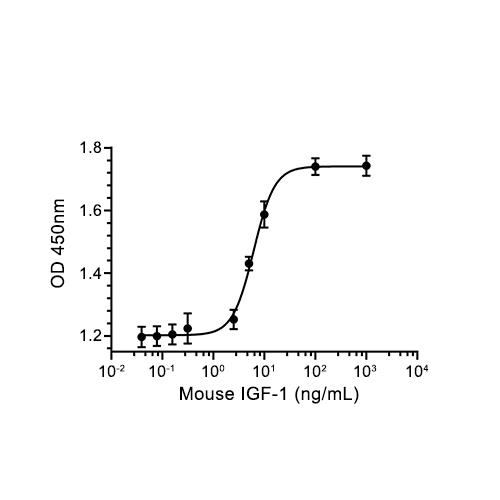| Description |
IGF-I/IGF-1 Protein, Human (70a.a) is a mitogenic cytokine, binds to IGF type 1 receptor, and modulates growth in many tissues, such as nervous tissue, lymphoid tissue, reproductive tissue, smooth muscle, endothelium, and bone; IGF-I/IGF-1 Protein also mediates neuroprotective mechanism. |
|---|---|
| Background |
Insulin-like growth factor (IGF) system has been shown to modulate growth in many tissues, such as nervous tissue, lymphoid tissue, reproductive tissue, smooth muscle, endothelium, and bone. Insulin-like Growth factor-1 (IGF-I) is produced by osteoblasts, and its mitogenic effects are mediated by their binding to the IGF plasma membrane receptors. The IGF type 1 receptor binding to both IGF-I and IGF-II, is thought to be the predominate receptor involved in mediating the effects of these growth factors in most cell types, including osteoblasts[1]. Insulin-like growth factor-1 (IGF-1) is a neurotrophic factor capable of mediating neuroprotective and neuroplasticity mechanisms. Targeted overexpression of IGF-1 enhances the generation of hippocampal newborn neurons in brain-injured mice[2]. |
| Biological Activity |
1.ED50 < 5 ng/mL, measured by a cell proliferation assay using FDC-P1 cells, corresponding to a specific activity of > 2.0×105 units/mg.
|
| Species |
Human |
| Source |
E. coli |
| Tag |
Tag Free |
| Accession |
P05019-1 (G49-A118) |
| Gene ID | |
| Molecular Construction |
N-term
IGF1 (G49-A118)
Accession # P05019-1 C-term
|
| Synonyms |
rHuIGF-1; IGF-IA; Somatamedin C; MGF; IGF-I
|
| AA Sequence |
GPETLCGAELVDALQFVCGDRGFYFNKPTGYGSSSRRAPQTGIVDECCFRSCDLRRLEMYCAPLKPAKSA |
| Molecular Weight |
Approximately 8-9 kDa |
| Purity |
|
| Appearance |
Lyophilized powder |
| Formulation |
Lyophilized from a 0.22 μm filtered solution of PBS, pH 7.4 or 20 mM NaAc-HAc, pH 4.5 or PBS, pH 7.4, 5% trehalose, 5% mannitol and 0.01% Tween80 or PBS, pH 7.4, 8% trehalose. |
| Endotoxin Level |
<1 EU/μg, determined by LAL method. |
| Reconstitution |
It is not recommended to reconstitute to a concentration less than 100 μg/mL in ddH2O. For long term storage it is recommended to add a carrier protein (0.1% BSA, 5% HSA, 10% FBS or 5% Trehalose). |
| Storage & Stability |
Stored at -20°C for 2 years from date of receipt. After reconstitution, it is stable at 4°C for 1 week or -20°C for longer (with carrier protein). It is recommended to freeze aliquots at -20°C or -80°C for extended storage. |
| Shipping |
Room temperature in continental US; may vary elsewhere. |
epigenetics modulation frontier
Master of Bioactive Molecules | Inhibitors, Screening Libraries & Proteins

